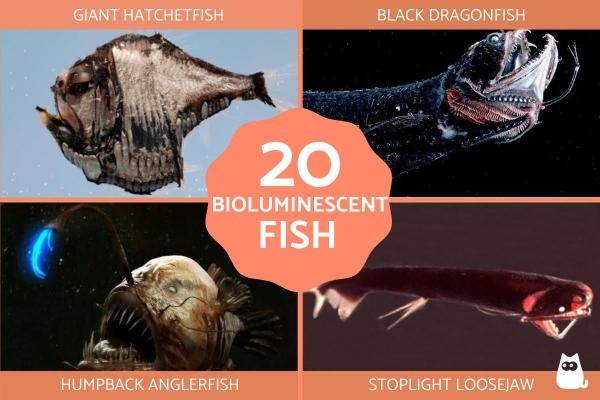
Deep beneath the ocean's surface, where sunlight can't reach, nature has evolved an extraordinary solution, fish that create their own light. These bioluminescent creatures illuminate the darkness through specialized light-producing organs called photophores, using them to hunt, communicate, and survive in the mysterious deep. Some use light as fishing lures, others for camouflage, and some even for finding mates in the vast darkness.
In this article, we explore 20 bioluminescent fish species with photos and fascinating facts, offering a glimpse into these remarkable deep-sea creatures that scientists are still working to understand fully.
Spotted lanternfish (Myctophum punctatum)
The Spotted lanternfish produces light through bioluminescence, making it one of the many species that illuminate the deep waters. While this fish reaches only 11 centimetres (4.3 inches) in length, its impact on marine ecosystems extends far beyond its size. Spotted lanternfish are incredibly abundant, making them a crucial food source for a wide range of marine life, including larger fish, whales, dolphins, and seabirds.
M. punctatum inhabits the eastern and western Atlantic Ocean, spanning from the cold waters of Greenland and Iceland to the United States coast and into the Mediterranean Sea.
As with many deep-sea species, the lanternfish follows a daily migration pattern. This movement takes it from the surface to depths of 750 metres (2,460 feet), with the fish staying in deep water during daylight hours before rising at night to feed.
The fish has a grey body with light-producing photophores running along its center. These natural lights help the lanternfish communicate with others, hide from predators, and attract mates. Their body shape helps them swim efficiently during their daily journeys between deep and shallow waters.
During its nightly ascent, the Spotted lanternfish feeds primarily on copepods and marine larvae. This vertical migration pattern serves a dual purpose: it allows the fish to access abundant food sources near the surface while minimizing exposure to predators. Such behavior links the species to both shallow and deep-water food webs.
Due to its widespread distribution and stable populations, the International Union for Conservation of Nature (IUCN) classifies this species as Least Concern.
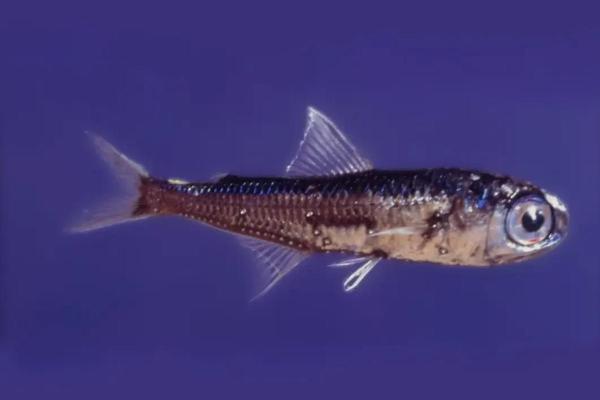
Giant hatchetfish (Argyropelecus gigas)
The Giant hatchetfish (Argyropelecus gigas) lives up to its name only in comparison to its relatives, while it's the largest species in its genus, it still reaches just 11 centimetres (4.3 inches) in length.
A. gigas has spread throughout the world's tropical and temperate oceans, appearing everywhere except the North Pacific. Though globally distributed, populations can be sparse in certain regions. These fish prefer depths between 400 to 600 metres (1,312 to 1,969 feet), where they form their largest concentrations.
The fish displays brown and grey coloring, blending with the dim waters of its deep habitat. Like other hatchetfish, its body has evolved to cope with the pressures and challenges of life in the mesopelagic zone, where sunlight barely reaches.
Giant hatchetfish have rows of light-producing organs (photophores) along their bellies. These lights emit a blue glow, helping them blend in with the faint light filtering down from the surface. This clever camouflage technique, called counter-illumination, makes them nearly invisible to predators looking up from below.
Unlike more specialized feeders, the Giant hatchetfish maintains a varied diet. They hunt smaller fish, zooplankton, annelids, and mollusks, making them versatile predators in their deep-water ecosystem. This diverse feeding strategy likely contributes to their success across different ocean regions.
The International Union for Conservation of Nature (IUCN) classifies this species as Least Concern. Their wide distribution and adaptable feeding habits help maintain stable populations despite local variations in abundance.
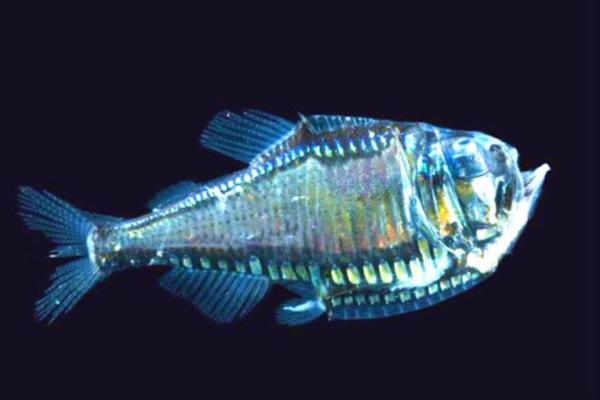
Black dragonfish (Idiacanthus atlanticus)
The Black dragonfish (Idiacanthus atlanticus) is one of the deep-sea fish species with the most pronounced sexual dimorphism. This bioluminescent species inhabits the southern oceans, where males and females live dramatically different lives.
I. atlanticus spans the Southern Hemisphere's subtropical and temperate waters, occasionally venturing into the subantarctic regions of the Southern Ocean. Males and females occupy distinct depth zones, creating a unique spatial separation between the sexes. Females swim at depths less than 500 metres (1,640 feet) and move closer to the surface at night. In contrast, males remain in deeper waters between 1,000 to 2,000 metres (3,281 to 6,562 feet).
The size difference between males and females is remarkable. Females reach 35 centimetres (13.8 inches) in length, with a black body and prominent teeth. Males, however, grow to only 5 centimetres (2 inches) and retain larval features throughout their lives.
Female dragonfish, with their well-developed teeth and larger size, serve as active predators in their environment. Their nightly vertical migrations suggest they follow prey movements, though specific feeding patterns need further study. Males, with their reduced size and simplified features, likely have different feeding strategies than females.
Despite their unusual biology, the International Union for Conservation of Nature (IUCN) lists this species as Least Concern. Their widespread distribution across the southern oceans helps maintain stable populations.
Did you know bioluminescence isn't unique to fish? Explore more amazing creatures that illuminate in our other article.
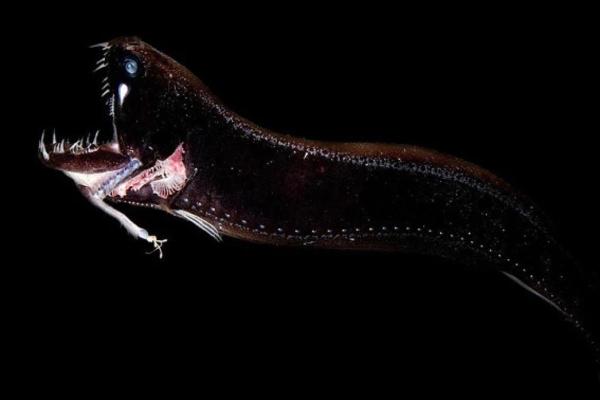
Humpback anglerfish (Melanocetus johnsonii)
The Humpback anglerfish (Melanocetus johnsonii) represents another example of extreme sexual dimorphism in the deep sea. Like many abyssal creatures, this species has evolved unique adaptations for survival in the darkness.
M. johnsonii inhabits all of the world's oceans, living in the mesopelagic and bathypelagic zones. These fish thrive at depths between 1,500 to 2,100 metres (4,921 to 6,890 feet), in complete darkness.
The size difference between males and females is impressive. Females grow to about 15 centimetres (5.9 inches) in length, while males reach only 2.8 centimetres (1.1 inches). Females have black bodies and carry a distinctive bioluminescent lure, which is a modified dorsal fin ray that extends from their head. This natural fishing rod, tipped with light-producing organs, attracts prey in the darkness.
Female Black devilfish can consume prey larger than themselves, using their bioluminescent lure as bait. Their expandable stomachs and jaws allow them to engulf surprisingly large prey.
Males, though tiny, have developed enhanced sensory organs that help them locate females in the vast darkness, a crucial adaptation for the species' survival. After finding a female, a male will attach himself to her body, fusing with her circulatory system and becoming essentially a permanent sperm-producing appendage.
The International Union for Conservation of Nature (IUCN) lists this species as Least Concern. Their widespread distribution across global oceans helps maintain stable populations despite the challenges of deep-sea life.
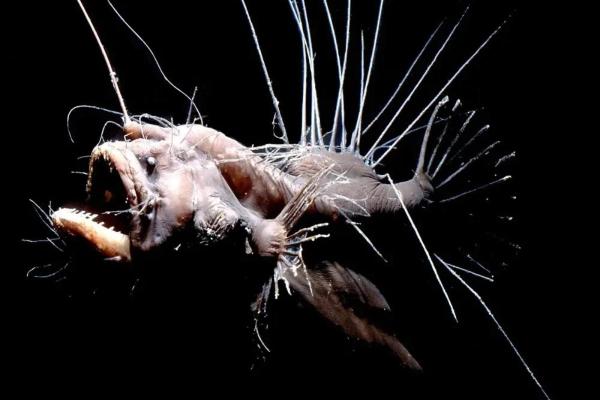
Pacific viperfish (Chauliodus macouni)
The Pacific viperfish (Chauliodus macouni) combines stealth and bioluminescence in the deep waters of the North Pacific. Among species in its genus, it stands as the largest, reaching 30 centimetres (11.8 inches) in length.
C. macouni inhabits a specific region of the Pacific Ocean, from Japanese waters through the Bering Sea, extending along the coasts of Canada and the United States, and south to Mexico's Gulf of California. These fish live in the mesopelagic zone, typically at depths around 800 metres (2,625 feet).
The fish's body displays an iridescent dark silver-blue coloration, overlaid with specialized ultra-black skin that helps control its bioluminescent signals. This dual-layer system gives the viperfish precise control over its visibility in the deep ocean. Females grow larger than males, following a pattern common among deep-sea species.
Their body design suits their predatory lifestyle, with prominent teeth and strong jaws for capturing prey. These teeth are so large that the fish has to open its jaws incredibly wide to accommodate them.The ultra-black skin coating serves a dual purpose. On one hand, it helps mask the fish's own bioluminescence while, on the other hand, it allows it to remain hidden from both predators and prey.
The International Union for Conservation of Nature (IUCN) lists this species as Least Concern. Despite their limited geographic range compared to some deep-sea fish, their populations remain stable.

Pelican eel (Eurypharynx pelecanoides)
The Pelican eel (Eurypharynx pelecanoides) is named for its most striking feature, a mouth that can expand to enormous proportions relative to its body.
E. pelecanoides inhabits tropical and temperate waters worldwide. While they can live anywhere between 500 to 7,625 metres (1,640 to 25,017 feet), most concentrate at depths of 1,200 to 1,400 metres (3,937 to 4,593 feet). This broad depth range makes them one of the most vertically widespread deep-sea species.
The fish grows to between 75 and 100 centimetres (29.5 to 39.4 inches) in length. Their black or olive-colored body features a distinctive whip-like tail equipped with light-producing organs.
Their most notable feature is their massive, pelican-like mouth, which can expand to accommodate prey much larger than their relatively small body size would suggest. Its mouth is so large that it can swallow prey several times its own size! Their lower jaw is loosely hinged, allowing them to open their mouths incredibly wide. They also have a long, whip-like tail that acts as a counterbalance.
Unlike many deep-sea specialists, the Pelican eel maintains a varied diet that includes fish, crustaceans, and squid. Their expandable mouth likely helps them take advantage of scarce feeding opportunities in the deep ocean. Due to their fragile body structure, many specimens reach the surface damaged, making detailed study challenging.
The International Union for Conservation of Nature (IUCN) lists this species as Least Concern. Their global distribution and wide depth range suggest stable populations, though direct observation remains difficult.
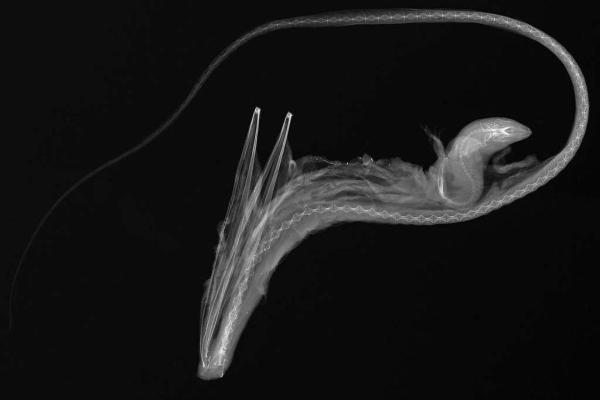
Whiptail gulper (Saccopharynx lavenbergi)
The Whiptail gulper (Saccopharynx lavenbergi) belongs to the fascinating family of gulper eels, adding to the diversity of bioluminescent deep-sea creatures. Their unique body form reflects specialized adaptations to life in the ocean depths.
This fish inhabits a specific region of the Eastern Pacific Ocean, ranging from the United States coastline south through the Galapagos Islands and along the Peru-Chile trench. These fish live in the bathypelagic zone, occupying depths between 1,000 to 2,500 metres (3,281 to 8,202 feet).
It reaches 95 centimetres (37.4 inches) in length, with a distinctively thin, elongated body and oversized mouth typical of gulper eels. Their dark body ends in a specialized tail tip containing bioluminescent organs, a feature that actually sets them apart from all the other deep-sea eel species.
Their large mouth and elongated form suggest they can capture and consume relatively large prey, though specific feeding behaviors remain poorly documented due to the challenges of observing animals at such depths.
The International Union for Conservation of Nature (IUCN) lists this species as Least Concern, despite the limited observations of live specimens. Their distribution across a large geographic range suggests stable populations.
If you're fascinated by bioluminescence, you'll love exploring the chemistry behind the fireflies' light.

Glacial lanternfish (Benthosema glaciale)
The Glacier lanternfish (Benthosema glaciale) performs daily journeys through the water column, joining the largest animal migration on Earth, the daily vertical movement of deep-sea creatures toward surface waters.
It ranges from the cold waters of Norway and Greenland, south to Morocco, and along the West African coast from Mauritania to Guinea. They also thrive throughout the Mediterranean Sea. These fish migrate daily, descending to depths of 800 metres (2,625 feet) during daylight and rising toward the surface at night to feed.
The fish reaches 10 centimetres (3.9 inches) in length, with a grey body that shows reddish tones on its dorsal surface. Like other lanternfish, they possess photophores (light-producing organs) along their ventral region, which aid in communication and camouflage.
Their vertical migration pattern aligns with their feeding strategy. By moving toward surface waters at night, they can access richer food sources while avoiding predators that rely on sight to hunt.
The International Union for Conservation of Nature (IUCN) lists this species as Least Concern. Their broad geographic distribution and successful adaptation to daily vertical migration suggest stable populations.

Electric lanternfish (Electrona risso)
Risso's lanternfish (Electrona risso) occupies specific temperature zones in the world's oceans, demonstrating how deep-sea species adapt to particular environmental conditions.
It follows distinct temperature preferences, inhabiting waters between 10°C and 15°C (50°F to 59°F) at depths around 200 metres (656 feet). Their global distribution focuses on two main bands: between 36°S and 23°S, and from 60°N to 52°S, including the Mediterranean Sea. This pattern shows how temperature, rather than geography alone, shapes their distribution.
Unlike many deep-sea species where females grow larger, male Risso's lanternfish reach about 8 centimetres (3.1 inches) while females measure around 5 centimetres (2 inches). Their silver bodies help them blend with the dim light at their preferred depths, while their photophores provide additional camouflage and communication capabilities.
Like other lanternfish, they migrate vertically through the water column between day and night. This behavior likely helps them balance feeding opportunities with predator avoidance, a common strategy among mesopelagic fishes. They also play a crucial role in the ocean's food web because they are a major food source for a wide variety of predators.
The International Union for Conservation of Nature (IUCN) lists this species as Least Concern. Their adaptation to specific temperature ranges rather than geographic locations may help them maintain stable populations despite changing ocean conditions.

Black loosejaw (Malacosteus niger)
The Black loosejaw (Malacosteus niger) stands out among deep-sea fish for its unique ability to produce red bioluminescence. In fact, it is one of the few animals in the world that can both produce and see red light. In the deep sea, red light is quickly absorbed by the water, making it effectively invisible to most other animals. This gives the Black Loosejaw a significant advantage when hunting, as it can illuminate its prey with red light without revealing its own position.
It has a global distribution, ranging from Arctic waters to tropical seas. Unlike most deep-sea fish that perform daily vertical migrations, the Stoplight loosejaw remains at its preferred depth. This unusual behavior suggests they've developed specialized feeding strategies that don't require following prey to shallower waters.
Growing up to 25 centimetres (9.8 inches) in length, this fish possesses specialized light organs near its eyes. What makes these organs remarkable is their ability to produce red light - a rare capability in the deep sea. Most marine organisms can't detect red light, giving the Stoplight loosejaw a natural stealth system for hunting.
The International Union for Conservation of Nature (IUCN) lists this species as Least Concern. Their widespread distribution across global oceans helps maintain stable populations.
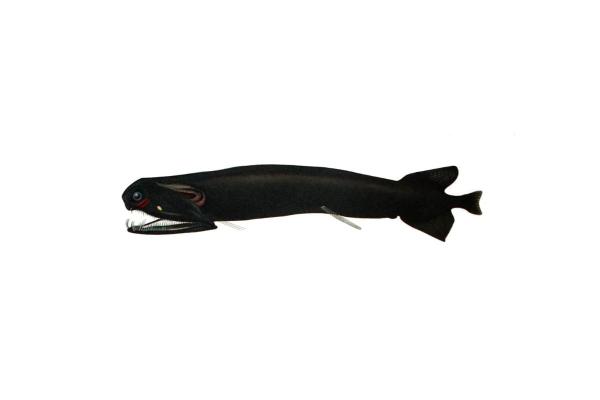
Other bioluminescent fish
From fish that live in the mesopelagic twilight zone to those that live in the dark bathypelagic depths, we have examined a number of species in this article that demonstrate the amazing range of bioluminescent fish. Here are some more examples and fun facts of the diversity of fish that create light in our oceans:
- Boa dragonfish (Stomias boa): known for its bioluminescent lure that it uses to attract prey.
- Crocodile lanternfish (Lampanyctus crocodilus): named for its crocodile-like appearance, with rows of sharp teeth.
- California headlightfish (Diaphus theta): possesses a bright, headlight-like photophore on its head.
- Triplewart seadevil (Cryptopsaras couesii): the males are parasitic, fusing with the female's body for life.
- Barreleye (Macropinna microstoma): has tubular eyes that can look upwards through its transparent head.
- Hector's lanternfish (Lampanyctodes hectoris): a deep-sea dweller that plays a crucial role in the ocean's food web.
- Günther's loosejaw (Photostomias guernei): has no floor to its mouth, allowing it to swing its jaw open wide enough to catch prey larger than its head.
- Trewavas dragonfish (Eustomias trewavasae): can extend its jaw up to 1/4 of its body length in a single snap.
- Highlight hatchetfish (Sternoptyx pseudobscura): its body is so thin it becomes nearly invisible when viewed from the side.
- Rakery beaconlamp (Thysanactis dentex): has needle-like teeth that are so long they extend beyond its closed mouth.
The deep sea holds more secrets than just glowing fish. Venture further into the abyss to meet more extraordinary creatures in our other article.
If you want to read similar articles to Bioluminescent Fish Species - Amazing Examples with Pictures, we recommend you visit our Facts about the animal kingdom category.
- Animal Diversity Web. (2020). Available at: https://animaldiversity.org/
- IUCN. (2024). The IUCN Red List of Threatened Species . Version 2024-2. Available at: https://www.iucnredlist.org